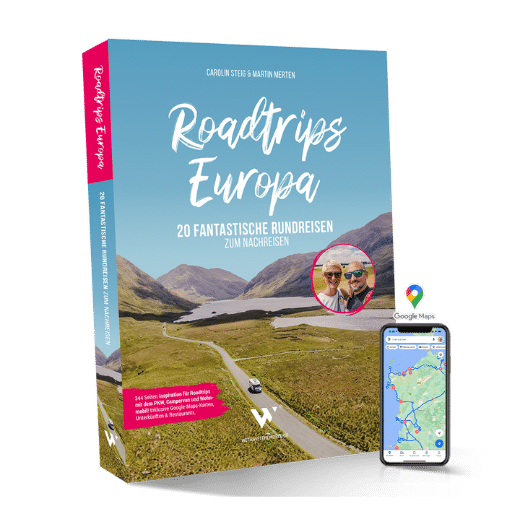Updated on November 20, 2025 by Angelika Klein
Can you imagine taking a road trip through Germany? Great idea! Germany is a wonderful country for a varied road trip. For me, a road trip is the best way to explore my home country. Being on the road in my own car gives me the freedom to take as much time as I want to get from A to B and to make unplanned stops when I feel like it. And - whether you like it or not - Germany is still a country of motorists. Almost every corner can be reached on relatively well-developed roads, and there are petrol stations everywhere. You can find some suggestions for exciting tours through Germany in my blog post Road Trip Germany - The Most Beautiful Routes with Highlights and Map.
In Germany and most European countries, planning a road trip is not a major challenge. Nevertheless, there are a few points you should bear in mind. Especially if you've never been on the road in a rental car before, there are a few pitfalls lurking. I will share with you in this article what points you should generally consider when planning a road trip .
1. Find the Right Destination
1.1 Initial Considerations about the Destination
- Coordination with travel partners:
If you don't want to go on your road trip alone, but as a couple or with several friends, discuss with your travel partners which destinations they can imagine and which activities they are particularly interested in. This way, you can choose a destination together that is exciting for everyone and takes different interests into account.
Tip: Only travel with people you know really well and who you know you can put up with 24/7. Quite a few relationships and friendships break up during a trip.
Also clarify in good time whether you prefer to book a single or double room. I, for example, need a lot of personal space and (with very few exceptions) always book a single room when I travel with others.
- Clarification of expectations and interests:
Discuss with your travel partners which sights and activities everyone is interested in, and what you can agree on. You can also do some things separately.
- Find out about the possible destinations:
I still love leafing through travel guides and get stacks of them from the public library to get an initial overview. At the same time, I browse through travel blogs and the websites of travel and rental car providers, where I sometimes find interesting route suggestions that I adapt to my needs.
1.2 Considerations on Country-Specific Factors
- Best time to travel, depending on climatic conditions, public holidays and peak travel times: The best time to travel depends not only on climatic conditions, but also on public holidays and peak travel times in the destination country. Avoid overcrowded vacation spots by taking public holiday calendars and peak travel times into account. It is just as important to make sure that the sights you want to visit are open. In Germany, for example, there are museums that have significantly reduced opening hours in winter, and some are even completely closed in the off-season.
- Take into account the topography of the country, weather conditions and road conditions: For 100 km in the mountains or on sandy tracks, you need to plan for many times the driving time as on the highway. Take this into account when planning your route in order to calculate realistic driving times. Google Maps will give you an initial indication of the travel times required.
If you're traveling through a cold country in winter, bear in mind that snowfall can significantly increase travel times (in Germany, you absolutely need to have a snow cover in winter - at least from November to March). Winter tires, and snow chains in the mountains!). Heavy rain can also make driving considerably more difficult/delayed.
- Traffic regulations in the destination country (right/left-hand traffic): Find out about the traffic regulations in your destination country, especially with regard to lane traffic, so that you are safe on the road. Think about whether you are confident enough to drive on the opposite side of the road to the one you are used to. I, for example, don't trust myself and would never drive in a country with left-hand traffic 😅. The same applies to countries with comparatively chaotic traffic conditions, such as India or other countries in Asia/Africa/Latin America.

1.3 Planning the Travel Budget
Thorough budget planning will help you to realistically estimate your travel costs and narrow down the possible destinations. Think about the following items:
- Travel costs (flight/train ticket if you are not traveling by car)
- Accommodation
- If applicable, costs for rental cars (note: one-way rentals are significantly higher than if you return the car at the pick-up location. It could therefore make sense to plan a round trip for cost reasons).
- Gasoline
- Catering
- Activities
- Charges for tolls and vignettes
- Other transportation costs (e.g. ferries, cabs, local public transport, domestic flights)
- National park fees, visitor's tax
- Visa fees
- Insurances
- Vaccinations and medication
- Include costs for a SIM card, WLAN, satellite if necessary
1.4 Duration and Length of the Road Trip
- Determining the duration of the trip:
Determine the total duration of your road trip based on your available vacation days, your budget and the planned activities. Also take into account the travel time to and from your destination.
- Rough planning of the possible itinerary:
Roughly plan the itinerary for the destination(s) in question according to the specified travel duration and your desired destinations. Take into account the distances between the individual stops and the travel times to ensure that you have enough time for sightseeing, unexpected discoveries and relaxation.
1.5 Safety, Health and Cultural Aspects
Find out in detail about the security situation in your destination country from the Federal Foreign Office, blogs, tourism and government websites. Are there travel warnings, dangerous areas, are certain vaccinations required?
- Consider health issues: Do you have a chronic illness, do you have to take medication regularly or are there other reasons why you might need medical assistance? Find out about the healthcare situation in the country and make a realistic assessment of which destinations are suitable for you under the circumstances.
- Information on potential risk areas (dangerous neighborhoods, cities or regions that should be avoided). A good source of information here is the Foreign Office.
- Include risks in your time planning: For example, in many African countries you should not drive after dark (Danger from wild animals on unlit roads, risk of robbery). Inform yourself in detail and plan your route and travel times accordingly!
- Petrol station, workshop and mobile network coverage check. In remote areas (e.g. in Africa) there is often no nationwide mobile phone network. If you are traveling there in a camper or car, a satellite phone may be useful. This is offered by some rental car companies.
- As a general rule: be realistic about your need for security and decide which countries are suitable for you personally for a road trip.
Make a decision!
If you've covered all these points, you've already done a lot. Hopefully the right destination for you has already emerged. Decide where you want to go!

Inspiration for your road trip *
Caro and Martin from WE TRAVEL THE WORLD present in their book Roadtrips Europa* 20 fantastic round trips in the most diverse regions of Europe. Two exciting routes in Germany are also included: one leads through eastern Saxony, the other through northern Baden-Württemberg.
What I like so much about this book is that the routes include many destinations off the beaten track. Only available in German language.
2. Plan and Prepare Your Trip
2.1 Important To-Dos in Good Time Before the Trip
- Flightsif necessary, select and book early.
- Entry formalities clarify (Federal Foreign Office, tourism authority of the destination country)
- Do you need a Passport? Is it still valid for at least 6 months and does it still have free pages for visa stamps?
- If applicable. Visa (in many countries this is now possible online).
- Are Vaccinations necessary? Before traveling abroad, I usually go to the Tropical Institute, which is only 20 km from my home. I receive detailed advice from a competent doctor there and get all the vaccinations I need straight away. Of course, you can also go to your family doctor.
- International driving license apply in good time, if necessary.
- Which Means of payment are accepted in the destination country? Do you need cash? In which currency? Credit cards are not accepted everywhere. Inform yourself thoroughly when traveling abroad.
- Will your Credit card accepted in the destination country? Is it still valid long enough?
- Travel insurance (at least travel health insurance).
- Travel cancellation insurance conclude.
- If you are flying to your destination: Clarify transportation to the airport/Possibly reserve a parking space at the airport.
- Get to know the Road traffic regulations and toll laws in the destination country familiar!
2.2 Route Planning and Selection of Interesting Stops
- Requirements for detailed planning
- Make sure that all travel partners get their money's worth. Take all interests into account or agree on a route before planning the exact route Compromisesso that everyone can enjoy the trip.
- Define a Maximum distance per daydepending on the conditions in the destination country.
- Plan for Buffer times for unforeseen events and spontaneous discoveries a. I've gotten into the habit of planning one day more than I need for each stage of a road trip, which has worked well.
- Work out the route
- Wear all Milestones into an Excel or Google spreadsheet (location, distance, length of stay, accommodation, costs, activities).
- Use Google Maps or another app for rough initial planning and estimating distances.
Tip: With the help of my Guide for creating your own map with Google My Maps (an extension of Google Maps) you can create your own individual travel map.
Important: For countries in the so-called Global South (Africa, Latin America and most Asian countries), you should definitely also use printed maps and up-to-date information from travel blogs and the tourism websites of the destination country. Google Maps is often not enough here, and you certainly don't want to get stuck somewhere in the middle of nowhere.
2.2 Accommodation Booking
Consider the following points when selecting accommodation:
- Type of accommodation (guesthouses, hotels, vacation apartments, tents, camper pitches) according to your preferences and budget.
- Consider the location of the accommodation. It makes little sense to drive 50 km to an attraction to save a few euros on accommodation costs.
- Select accommodation/pitches and book in good time if necessary. Whether you pre-book everything or not depends on your preferences. Maybe you are the spontaneous type, like to make decisions at short notice and are willing to accept not staying at the desired location and in the best location. I, on the other hand, always want to be sure of staying in the best location at the best possible price-performance ratio - that's why I always pre-book all my overnight stays.
2.3 Booking a Vehicle or Preparing Your Own Car for the Trip
Important tip: Always book your rental car well in advance - this saves costs and nerves. With most car rental companies, you can cancel free of charge if something does come up. Use comparison portals such as billiger-mietwagen.de and check24.de.
The following considerations are important when selecting a vehicle:
- Own car or rental car?
- Car or camper?
- Rental car companies often have Age limits or additional costs for drivers under 21 or 25. Find out more!
- Size of the vehicle: How much luggage space do you need? In the USA or Canada, a larger car means more driving comfort, whereas in southern European countries such as Spain or Italy, a large car is more of a hindrance due to the narrow roads in many places.
- Transmission type: Gearshift or automatic? I would always prefer automatic when driving through the mountains.
- Does the vehicle have to be suitable for off-road use (all-wheel drive)?
- Do you need Winter tires or even Snow chains?
- Book liability and fully comprehensive insurance at the same time. Third-party liability: cover of at least €1 million, fully comprehensive insurance including glass and tires if possible. I've already had two accidents with the rental car and was very happy about the fully comprehensive insurance. That would have cost me dearly!
- Observe fair refueling regulations. The usual rule is "full - full", i.e. you pick up the car with a full tank and return it with a full tank. If you forget to refuel, you will be charged a high price for the full tank.
- Unlimited kilometers
- Note one-way feeIt can make sense to accept the expensive one-way fee. For example, we did this in Canada on the route from Jasper to Calgary and also in Portugal on a road trip from Porto to the Algarve. If you don't want to drive back to the starting point, it costs extra. Be sure to clarify the amount of the one-way fee in advance!
- Observe the 24-hour rule: If you pick up the car at 11 a.m., you must return it by 10:59 a.m. at the latest, otherwise you will be charged for another day.
- Book the necessary extras: Think about GPS or even (in remote regions) a satellite phone. Of course, what you need depends on your personal safety requirements.
- If you are taking your road trip in your own car, think about the following in good time TÜV/Inspection.
- What documents does the rental car company require? Check the contract in good time, preferably at the time of booking.
- Check the validity of your credit card. You must pay the deposit by credit card when you pick up the car. The person making the booking, the driver and the credit card holder must be the same person.
- If applicable. International driving license request.
2.4 Clarification of Responsibilities in Preparation for and During the Trip
- Discuss the responsibilities of each travel partner for preparation and during the trip. This may involve planning activities, navigation or catering. Do you take turns driving? Does the co-driver make sure you take the right roads and exits? There is potential for conflict here, which should be cleared out of the way in good time.
A clear division of tasks will help to ensure that your road trip is a great experience and that you are still friends after the trip.
3. Prepare Travel Equipment
Before you set off, you should make sure that you don't forget anything essential. I always reserve a corner of the living room table days before I leave, where I put everything that absolutely has to be in my backpack for the trip. Here's a list of some essentials to help you remember:
- All important documents [Passport copy, visa, proof of vaccination, tickets, booking documents, travel insurance, etc. in a cloud (Google Drive, iCloud, Dropbox ...)] AND offline to be able to access them even without a network
- Road maps and travel guide (optional)
- If necessary, have a first aid kit, tools and navigation device ready
- USB adapter for your cell phone (to charge it in the car).
- Powerbank
- SD cards
- Charging cable for cell phone and tablet
- Adapter for sockets, if necessary
- Camera
- Save emergency contacts and breakdown services in your cell phone
- Flashlight
- Pocket knife (not in your hand luggage if you are flying to the starting point of your road trip!)
- Think of spare canisters if necessary
- Drinks, paper tissues, possibly a roll of toilet paper for on the go
- Pack your driver's license, ID cards, visas, tickets and travel documents!
Conclusion
A road trip offers the freedom to explore the world and experience new adventures according to your own ideas and desires. While planning a road trip can present some challenges, it's worth the effort to find the ideal route and create lasting memories. Whether you're traveling solo or with friends, the world is waiting to be explored! So, get ready for exciting experiences and embark on your unforgettable road trip adventure!






Trackbacks/Pingbacks